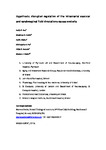Hypothesis: Disrupted Regulation of the Intracranial Vascular and Cerebrospinal Fluid Circulations Causes Nocturia
| dc.contributor.author | Roy, Holly | |
| dc.contributor.author | Smith, MD | |
| dc.contributor.author | Blaber, H | |
| dc.contributor.author | Fry, CH | |
| dc.contributor.author | Pereira, EA | |
| dc.contributor.author | Drake, MJ | |
| dc.date.accessioned | 2022-08-15T12:09:59Z | |
| dc.date.issued | 2022-01-17 | |
| dc.identifier.issn | 2405-4569 | |
| dc.identifier.issn | 2405-4569 | |
| dc.identifier.uri | http://hdl.handle.net/10026.1/19534 | |
| dc.description | File replaced (incorrect version) on 15/8/2022 by KT (LDS). | |
| dc.description.abstract |
Nocturia is a prevalent condition and may result from nocturnal polyuria, whereby overnight urine production is excessive. Anecdotal cases of idiopathic nocturnal polyuria in which cerebrospinal fluid (CSF) disorders were identified suggest a potential mechanism. The skull constrains three circulatory systems: the CSF, interstitial fluid, and vascular supply. For each, fluid dynamics (pressure, volume, and flow) are closely regulated and adapt to changes such as recumbency and circadian variation. Pathologies disrupting this regulation, and thus impairing intracranial fluid dynamics, will place the brain environment at risk. Hence, compensatory responses are needed to maintain safe limits and prevent neurological deficits. We hypothesise that a change in the fluid dynamics for the intracranial CSF, interstitial, or vascular circulation means that positional or circadian changes during sleep trigger compensatory hormonal responses to protect the brain, but these also cause nocturnal polyuria. Natriuretic hormones are candidate mediators for protection against excess intracranial pressure or volume. PATIENT SUMMARY: A need to pass urine during the night, which is called nocturia, may be because of excessive overnight urine production. We propose that changes in fluid dynamics in the brain caused by lying down or daily body rhythms may trigger the release of hormones that could be a factor in nighttime urine production. This hypothesis should be explored in further investigations. | |
| dc.format.extent | 60-65 | |
| dc.format.medium | Print-Electronic | |
| dc.language | en | |
| dc.language.iso | eng | |
| dc.publisher | Elsevier BV | |
| dc.subject | Humans | |
| dc.subject | Nervous System Diseases | |
| dc.subject | Nocturia | |
| dc.subject | Polyuria | |
| dc.title | Hypothesis: Disrupted Regulation of the Intracranial Vascular and Cerebrospinal Fluid Circulations Causes Nocturia | |
| dc.type | journal-article | |
| dc.type | Journal Article | |
| dc.type | Review | |
| plymouth.author-url | https://www.webofscience.com/api/gateway?GWVersion=2&SrcApp=PARTNER_APP&SrcAuth=LinksAMR&KeyUT=WOS:000760997600011&DestLinkType=FullRecord&DestApp=ALL_WOS&UsrCustomerID=11bb513d99f797142bcfeffcc58ea008 | |
| plymouth.issue | 1 | |
| plymouth.volume | 8 | |
| plymouth.publication-status | Published | |
| plymouth.journal | European Urology Focus | |
| dc.identifier.doi | 10.1016/j.euf.2022.01.004 | |
| plymouth.organisational-group | /Plymouth | |
| plymouth.organisational-group | /Plymouth/Faculty of Health | |
| plymouth.organisational-group | /Plymouth/Faculty of Health/Peninsula Medical School | |
| plymouth.organisational-group | /Plymouth/REF 2021 Researchers by UoA | |
| plymouth.organisational-group | /Plymouth/REF 2021 Researchers by UoA/UoA01 Clinical Medicine | |
| plymouth.organisational-group | /Plymouth/Research Groups | |
| plymouth.organisational-group | /Plymouth/Research Groups/FoH - Applied Parkinson's Research | |
| plymouth.organisational-group | /Plymouth/Users by role | |
| plymouth.organisational-group | /Plymouth/Users by role/Academics | |
| plymouth.organisational-group | /Plymouth/Users by role/Researchers in ResearchFish submission | |
| dc.publisher.place | Netherlands | |
| dcterms.dateAccepted | 2022-01-05 | |
| dc.rights.embargodate | 2023-1-17 | |
| dc.identifier.eissn | 2405-4569 | |
| dc.rights.embargoperiod | Not known | |
| rioxxterms.versionofrecord | 10.1016/j.euf.2022.01.004 | |
| rioxxterms.licenseref.uri | http://www.rioxx.net/licenses/all-rights-reserved | |
| rioxxterms.licenseref.startdate | 2022-01 | |
| rioxxterms.type | Journal Article/Review |


